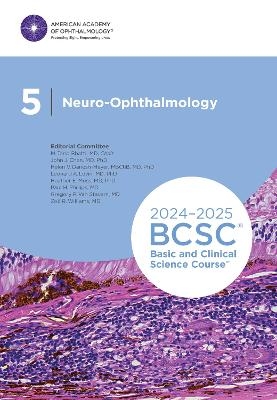
2024-2025 Basic and Clinical Science Course, Section 5
Neuro-Ophthalmology
Seiten
2024
American Academy of Ophthalmology (Verlag)
978-1-68104-787-4 (ISBN)
American Academy of Ophthalmology (Verlag)
978-1-68104-787-4 (ISBN)
Equip ophthalmic residents with the Academy’s definitive curriculum. Section 5 provides a symptom-driven approach to diagnosing and treating major neuro-ophthalmic conditions. The emphasis is on the patient’s examination and the appropriate use of adjunctive studies to determine the status of the patient’s visual system as a whole.
Section 5 of the Academy's Basic and Clinical Science Course™ (BCSC®) provides a symptom-driven approach to diagnosing and treating major neuro-ophthalmic conditions. Accordingly, the emphasis is on the patient's examination, both basic and extended, and the appropriate use of adjunctive studies to determine the status of the patient’s visual system as a whole.
Section 5 includes a chapter on imaging in neuro-ophthalmology, which contains pages devoted to interpreting optical coherence tomography results (OCT), a chapter on functional neurological symptoms (conversion) and related disorders, and an overview of the most recent diagnostic categorization of these disorders.
Numerous illustrations accompany an overview of the anatomy of visual pathways. Increase your understanding with videos, activities on orbital anatomy and the visual pathways, and an animation demonstrating visual snow. Both print and eBook users have access to the videos and activities.
Upon completion of Section 5, readers should be able to:
Explain a symptom-driven approach to the assessment of patients with common neuro-ophthalmic clinical manifestations and state an appropriate differential diagnosis.
Describe a plan for the immediate management of patients with neuro-ophthalmic emergencies.
Describe eye movement disorders and their anatomical relationship to the ocular motor system.
Section 5 of the Academy's Basic and Clinical Science Course™ (BCSC®) provides a symptom-driven approach to diagnosing and treating major neuro-ophthalmic conditions. Accordingly, the emphasis is on the patient's examination, both basic and extended, and the appropriate use of adjunctive studies to determine the status of the patient’s visual system as a whole.
Section 5 includes a chapter on imaging in neuro-ophthalmology, which contains pages devoted to interpreting optical coherence tomography results (OCT), a chapter on functional neurological symptoms (conversion) and related disorders, and an overview of the most recent diagnostic categorization of these disorders.
Numerous illustrations accompany an overview of the anatomy of visual pathways. Increase your understanding with videos, activities on orbital anatomy and the visual pathways, and an animation demonstrating visual snow. Both print and eBook users have access to the videos and activities.
Upon completion of Section 5, readers should be able to:
Explain a symptom-driven approach to the assessment of patients with common neuro-ophthalmic clinical manifestations and state an appropriate differential diagnosis.
Describe a plan for the immediate management of patients with neuro-ophthalmic emergencies.
Describe eye movement disorders and their anatomical relationship to the ocular motor system.
| Erscheinungsdatum | 22.08.2024 |
|---|---|
| Verlagsort | San Francisco |
| Sprache | englisch |
| Themenwelt | Medizin / Pharmazie ► Medizinische Fachgebiete ► Augenheilkunde |
| ISBN-10 | 1-68104-787-X / 168104787X |
| ISBN-13 | 978-1-68104-787-4 / 9781681047874 |
| Zustand | Neuware |
| Haben Sie eine Frage zum Produkt? |
Mehr entdecken
aus dem Bereich
aus dem Bereich
Ein systematischer Ansatz
Buch | Hardcover (2022)
Urban & Fischer in Elsevier (Verlag)
CHF 369,95


